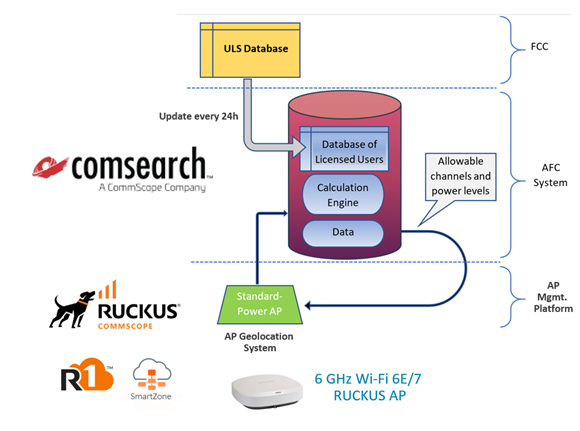Bem-vindo à RUCKUS Networks, parte do portfólio líder mundial de soluções de rede da CommScope. Saiba mais.
On April 16 2024, the RUCKUS® R770 Wi-Fi 7 Access Point received FCC certification for the use of 6 GHz standard power (SP) mode controlled by an Automated Frequency Coordination (AFC) system.
This enables the R770, the first Wi-Fi 7 AP to receive AFC device certification, to operate in standard power mode (SP) dramatically increasing the range and performance of the AP when used under the control of an AFC system.
AFC is also a requirement for any outdoor 6 GHz Wi-Fi®. As there isn’t an alternate operating mode (unlike indoor deployments which can revert to another mode in the absence of AFC) the approval of AFC was the last hurdle for 6 GHz to be fully integrated into the Wi-Fi world. Standard Power mode with AFC offers a potential of up to 36 dBm radiated power, at least four times the power of an indoor AP.
6 GHz: The new frontier for Wi-Fi
The Federal Communications Commission's (FCC) decision to release the 6 GHz band for unlicensed Wi-Fi operations garnered global acclaim, heralding a new era of possibilities for wireless connectivity. This new spectrum frontier promises quantum leap improvement in data speeds and capacity compared to the 2.4 GHz and 5 GHz Wi-Fi bands.
The 6 GHz spectrum is at the core of Wi-Fi 7 innovations, however, this coveted bandwidth is already used by preexisting technologies, such as fixed satellite services (FSS) deployed by the broadcast, cable and wireless industries, and point-to-point microwave links thus necessitating regulatory measures to safeguard incumbent users.
Policing the 6 GHz spectrum: Why do we need AFC?
To mitigate potential disruptions to incumbent 6 GHz services, the FCC has defined two distinct transmission modes for 6 GHz Wi-Fi with different transmit power levels: Low Power Indoor (LPI) mode for indoor Wi-Fi deployments and Standard Power mode available for both indoor and outdoor deployments.
Low power mode presents minimal interference risks due to lower transmit power combined with signal attenuation by building structures. Conversely, standard power mode, with higher power output and potential outdoor deployment, poses a heightened risk of encroaching upon existing 6 GHz users. To mitigate disruptions, the FCC crafted an innovative spectrum coordination solution—the Automated Frequency Coordination (AFC) system.
A simple and effective solution to manage spectrum
Automated Frequency Coordination (AFC) is a spectrum management system that informs standard power APs of the frequencies and maximum radiated power on which they can operate without causing degradation to incumbent systems. The AFC catalogues the spectrum landscape within a given area by using a database detailing the utilization of various radio frequencies by a range of incumbent services.
Although new in the realm of Wi-Fi, AFC bears resemblance to existing frameworks supporting TV white space (White-Fi) and CBRS wireless operations. AFC combines technological innovation and regulatory compliance, ensuring harmonious coexistence among diverse spectrum occupants. Under the purview of AFC, APs operating in standard power mode must interface with an AFC service provider to secure the integrity of incumbent 6 GHz operations against potential RF interference.
How AFC works
AFC service providers must use FCC-provided databases containing information on incumbent 6 GHz operators including location, frequencies, and other configuration data. Leveraging these databases, AFC service providers calculate frequency availability for standard power access points at their operating locations. All indoor or outdoor standard power 6 GHz Wi-Fi APs are required by the FCC to use an AFC service.
Prior to initiating transmission, a standard power AP engages in a consultative exchange with the local AFC system following a structured protocol: The AP provides details regarding its location and requested frequency information. AFC systems respond to initial usage requests, by providing available center frequencies which correspond to bandwidths and corresponding radiated power. Only upon receiving AFC approval/confirmation can the 6 GHz access point commence operations in standard power mode.
Once established, SP mode APs are required to check in with the AFC on a regular basis (every 24 hours) to confirm their current operating channel information based on the last successful AFC response. The AFC will validate the operation or send new operating information if needed.
RUCKUS AFC solution
The RUCKUS solution is based on the Comsearch® AFC system which leverages nearly five decades of experience in microwave frequency coordination and expertise with cloud-enabled, data-centric dynamic spectrum management systems. In addition to the FCC 6 GHz Universal Licensing System (ULS) database, our AFC solution also accesses Comsearch proprietary databases, which contain exhaustive information on incumbent system configurations developed over the years. Our proprietary interference analysis and frequency coordination engine enables seamlessly coordinated co-existence between unlicensed Standard Power users and incumbent point-to-point microwave users in the 6 GHz band.
With the proven history of Comsearch in coordinating outdoor wireless combined with the superior Wi-Fi delivered by RUCKUS, and with the first Wi-Fi 7 APs to be certified for Standard Power operation with AFC, it’s time to join the next evolution in Wi-Fi with RUCKUS Networks.
Since the RUCKUS R770 platform is driven by RUCKUS AITM, the complexity of channel planning across Low Power Indoor and Standard Power modes in the 6GHz band will also be automatically resolved and optimized by our enhanced AI-Driven RRM (radio resource management) to include AFC.
Learn more about Wi-Fi 7.
This piece was made possible by the significant contributions of several key individuals:
- Val Tankov
- Jim Palmer
- Anand Krishnamachari
- SeeHo Ting
- Tuofu Lu
========================================================================
© 2024 CommScope, LLC. All rights reserved. CommScope and the CommScope logo are registered trademarks of CommScope and/or its affiliates in the U.S. and other countries. For additional trademark information see https://www.commscope.com/trademarks. Wi-Fi, Wi-Fi 6, Wi-Fi 6E and Wi-Fi 7 are trademarks of the Wi-Fi Alliance. All product names, trademarks and registered trademarks are property of their respective owners.
Get ahead with RUCKUS Networks!
Sign up for exclusive insights from RUCKUS Networks.









